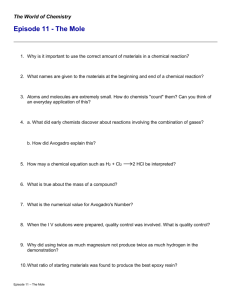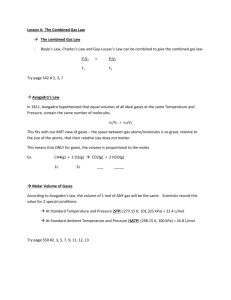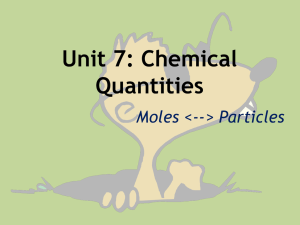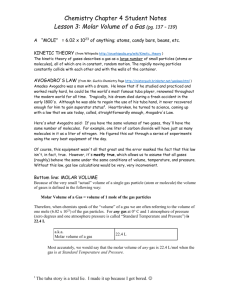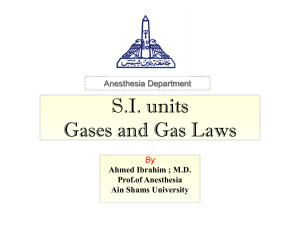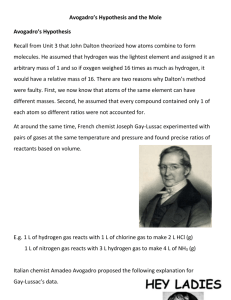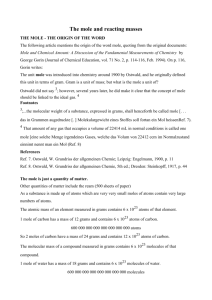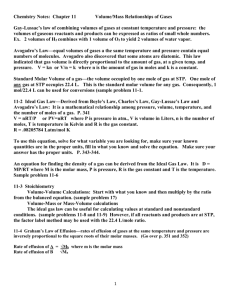Avogadro`s number - River Dell Regional School District
advertisement
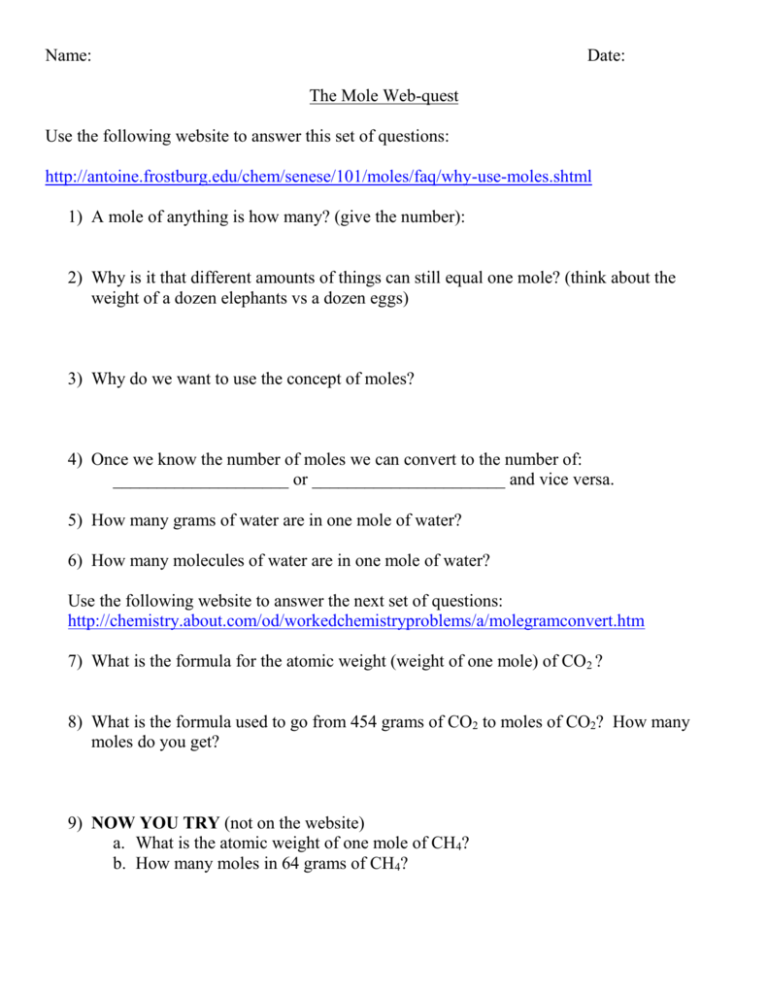
Name: Date: The Mole Web-quest Use the following website to answer this set of questions: http://antoine.frostburg.edu/chem/senese/101/moles/faq/why-use-moles.shtml 1) A mole of anything is how many? (give the number): 2) Why is it that different amounts of things can still equal one mole? (think about the weight of a dozen elephants vs a dozen eggs) 3) Why do we want to use the concept of moles? 4) Once we know the number of moles we can convert to the number of: ____________________ or ______________________ and vice versa. 5) How many grams of water are in one mole of water? 6) How many molecules of water are in one mole of water? Use the following website to answer the next set of questions: http://chemistry.about.com/od/workedchemistryproblems/a/molegramconvert.htm 7) What is the formula for the atomic weight (weight of one mole) of CO2 ? 8) What is the formula used to go from 454 grams of CO2 to moles of CO2? How many moles do you get? 9) NOW YOU TRY (not on the website) a. What is the atomic weight of one mole of CH4? b. How many moles in 64 grams of CH4? 10)What is the formula to determine the mass in grams of 3.6 moles of H2SO4? 11)NOW YOU TRY (not on website) a. What is the mass in grams of 4.2 moles of FeO2? Use the following website to answer the next set of questions: http://misterguch.brinkster.net/molecalculations.html Scroll down to “solving a 2 part chemistry problem” 12) What are the steps needed to convert 22 grams of copper to atoms of copper. Please write them out (include the chart we did in class) 13) NOW YOU TRY: How many atoms are there in 34 grams of Lithium? Show your work!!!!!!! Go to the bottom of this document and read all about “Amadeo Avagadro” to answer the next set of questions: 14) What is Avogadro’s full name? 15) Originally, what profession was Avogadro? 16) In 1811 Avogadro wrote a paper that clearly distinguished a _____________ from a _____________. 17) What is Avogadro’s Principle? 18) List one crazy fact about Avogadro’s number. All the information you have found so far has come from various websites. So what makes a source good or bad? Read the following pages and answer the questions that follow. Amedeo Avogadro Avogadro - the man Lorenzo Romano Amedeo Carlo Avogadro, conte di Quaregna e di Cerreto (1776 - 1856), was born in Turin, Italy, on 9th August, 1776. He was the son of Count Filippo Avogadro and Anna Maria Vercellone. His father was a distinguished lawyer and civil servant, becoming a senator of Piedmont in 1768, and was appointed advocate general to the senate of Vittorio Amedeo III in 1777. Under the French rule of 1799 he was made president of the senate. Amedeo Avogadro went to school in Turin. Coming from a family of well established ecclesiastical lawyers, Avogadro was guided toward a legal career, and became a bachelor of jurisprudence in 1792, at the ripe old age of just 16 years. Four years later he gained his doctorate in ecclesiastical law and began to practice. In 1801 he was appointed secretary to the prefecture of the department of Eridano. In spite of his successful legal career, Avogadro also showed an interest in natural philosophy, and in 1800 he began private studies of mathematics and physics. His first scientific research in 1803, undertaken jointly with his brother Felice, was on electricity. In 1806, Avogadro was appointed demonstrator at the Academy of Turin, and in 1809 became professor of natural philosophy at the college of Vercelli. In 1820, when the very first chair of mathematical physics in Italy was established at the University of Turin, Avogadro was appointed. Unfortunately, his post was short lived, since political changes suppressed the chair and Avogadro was out of a job by July, 1822. The chair was eventually reestablished in 1832, and Avogadro was reappointed to the position in 1834. Here he remained until his retirement in 1850. Avogadro had succeeded to his father's title in 1787. He married Felicita Mazzé, and they had a total of six children. Avogadro led an industrious life, and was a modest man, working in isolation. This probably contributed to his relative obscurity, particularly outside Italy. Avogadro died on the 9th July, 1856. He was described as religious, but not a bigot. Avogadro - his contribution to chemistry In order to understand the contribution that Avogadro made, we must consider some of the ideas being developed at this time. Chemistry was just beginning to become an exact science. The Law of Definite Proportions and the Law of Multiple Proportions were well accepted by 1808, at which time John Dalton published his New System of Chemical Philosophy. Dalton proposed that the atoms of each element had a characteristic atomic weight, and that it was atoms that were the combining units in chemical reactions. Dalton had no method of measuring atomic weights unambiguously, so made the incorrect assumption that in the most common compound between two elements, there was one atom of each. At around this time, Gay-Lussac was studying the chemical reactions of gases, and found that the ratios of volumes of the reacting gases were small integer numbers. This provided a more logical method of assigning atomic weights. Gay-Lussac did not carry through the full implications of his work. However, Dalton realized that a simple integral relation between volumes of reacting gases implied an equally simple relation between reacting particles. Dalton still equated particles with atoms, and could not accept how one particle of oxygen could yield two particles of water. This was a direct threat to the relatively new atomic theory, and therefore Dalton tried to discredit the work of Gay-Lussac. In 1811, Avogadro published an article in Journal de physique that clearly drew the distinction between the molecule and the atom. He pointed out that Dalton had confused the concepts of atoms and molecules. The "atoms" of nitrogen and oxygen are in reality "molecules" containing two atoms each. Thus two molecules of hydrogen can combine with one molecule of oxygen to produce two molecules of water. Avogadro suggested that equal volumes of all gases at the same temperature and pressure contain the same number of molecules which is now known as Avogadro's Principle. The work of Avogadro was almost completely neglected until it was forcefully presented by Stanislao Cannizarro at the Karlsruhe Conference in 1860. He showed that Avogadro's Principle could be used to determine not only molar masses, but also, indirectly, atomic masses. The reason for the earlier neglect of Avogadro's work was probably the deeply rooted conviction that chemical combination occurred by virtue of an affinity between unlike elements. After the electrical discoveries of Galvani and Volta, this affinity was generally ascribed to the attraction between unlike charges. The idea that two identical atoms of hydrogen might combine into the compound molecular hydrogen was abhorrent to the chemical philosophy of the early nineteenth century. Avogadro - his number It was long after Avogadro that the idea of a mole was introduced. Since a molecular weight in grams (mole) of any substance contains the same number of molecules, then according to Avogadro's Principle, the molar volumes of all gases should be the same. The number of molecules in one mole is now called Avogadro's number. It must be emphasized that Avogadro, of course, had no knowledge of moles, or of the number that was to bear his name. Thus the number was never actually determined by Avogadro himself. As we all know today, Avogadro's number is very large, the presently accepted value being 6.0221367 x 1023. The size of such a number is extremely difficult to comprehend. There are many awe-inspiring illustrations to help visualize the enormous size of this number. For example: • An Avogadro's number of standard soft drink cans would cover the surface of the earth to a depth of over 200 miles. • If you had Avogadro's number of unpopped popcorn kernels, and spread them across the United States of America, the country would be covered in popcorn to a depth of over 9 miles. • If we were able to count atoms at the rate of 10 million per second, it would take about 2 billion years to count the atoms in one mole. Determination of the number Cannizarro, around 1860, used Avogadro's ideas to obtain a set of atomic weights, based upon oxygen having an atomic weight of 16. In 1865, Loschmidt used a combination of liquid density, gaseous viscosity, and the kinetic theory of gases, to establish roughly the size of molecules, and hence the number of molecules in 1 cm3 of gas. During the latter part of the nineteenth century, it was possible to obtain reasonable estimates for Avogadro's number from sedimentation measurements of colloidal particles. Into the twentieth century, then Mullikan's oil drop experiment gave much better values, and was used for many years. A more modern method is to calculate the Avogadro number from the density of a crystal, the relative atomic mass, and the unit cell length, determined from x-ray methods. To be useful for this purpose, the crystal must be free of defects. Very accurate values of these quantities for silicon have been measured at the National Institute for Standards and Technology (NIST). To use this approach, it is necessary to have accurate values of atomic weights, often obtained by measuring the mass of atomic ions. For example, an ion trap, employing extremely uniform and stable magnetic and electric fields should allow such measurements to be made to better than 1 part in 1010. The relative atomic mass of silicon is particularly important, since silicon crystals are used in the x-ray methods mentioned above. As a continuation of this approach, one of the 1999 NIST Precision Measurement Grants was awarded to David Pritchard, physics professor at the Massachusetts Institute of Technology. He will conduct cyclotron frequency measurements on ions that could achieve a 100-fold improvement in the accuracy of atomic mass measurements. MIT has developed the world's most accurate mass spectrometer capable of measuring the atomic mass of atoms to one part in 10 billion. Pritchard proposes to simultaneously measure the cyclotron frequencies of two different ions in order to improve the values of several fundamental constants, including Avogadro's number. At the present time, information on Avogadro's number from many different experiments is pooled with other observations on other physical constants. A most probable and self-consistent set of physical constants that best fits all reliable data is then found by statistical methods. The size of Avogadro's number is determined by our definition of the mole. What it does demonstrate is how small an atom or molecule is compared to the amounts of material we are familiar with in everyday life, since the definition of the mole involves amounts of material we are completely familiar with.

